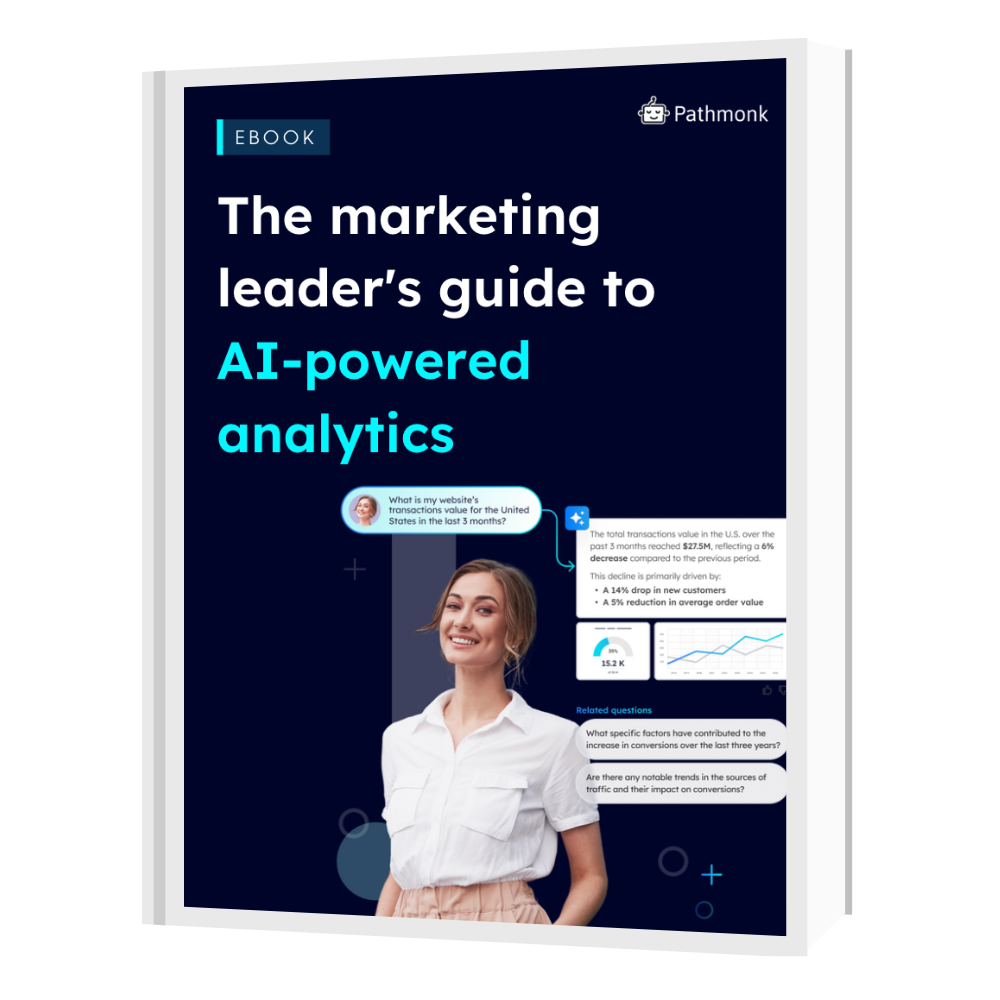Understanding and mapping your marketing touchpoints helps businesses understand the various stages customers go through before making a purchase. This includes every interaction from initial awareness through consideration to the final purchase decision.
Knowing this journey helps tailor marketing strategies to better meet the needs and behaviors of customers at each stage. So, in this article we’re going to give you an easy step-by-step guide to uncover your best-performing touchpoints using Pathmonk Intelligence.
Table of Contents
Step-By-Step: Mapping Your Marketing Touchpoints with Pathmonk Intelligence
1. Define and Track Your Touchpoints
First, you need to identify all the places where customers interact with your brand, such as emails, social media, ads, and direct visits to your website. If you need help defining your strategic touchpoints, download our free template.
Free template: customer journey touchpoints
Map your marketing touchpoints and understand your users' journey to conversion across all stages
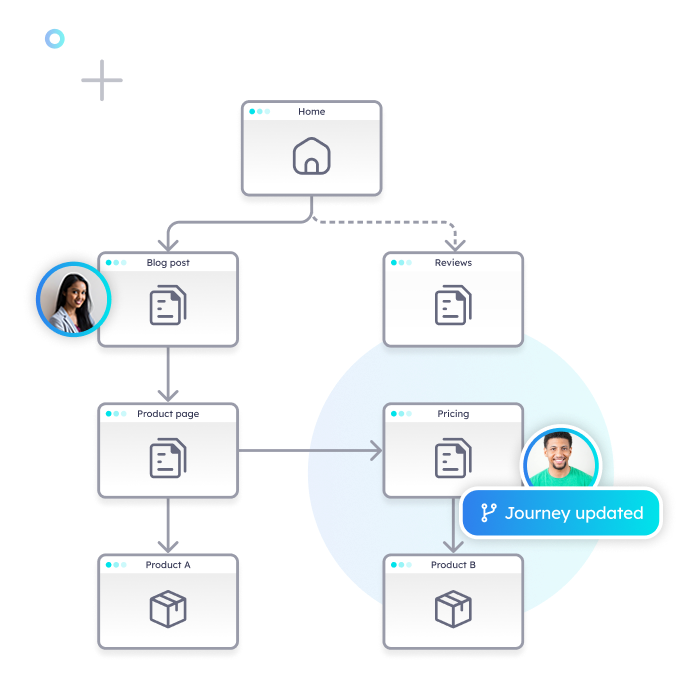
Once you have a fully understanding of all your touchpoints, you have to add UTM parameters to the URLs of your marketing campaigns. These parameters include source, medium, and campaign name, and they help Pathmonk Intelligence track where your traffic comes from.
For example, a link from a Facebook ad might have a URL like this:
https://www.yourwebsite.com/?utm_source=facebook&utm_medium=cpc&utm_campaign=summer_sale
If you’re new to this type of tracking, we have a quick article with more information on how to properly set your UTMs to get you started.
2. Configure Goals
In your Pathmonk dashboard, navigate to the upper menu, click on “Intelligence,” and then select “Website Goals“.

Here, you can set up goals to track when users complete key actions that are valuable to your business, such as signing up for a newsletter, making a purchase, or filling out a contact form. This setup enables you to later identify which touchpoints are driving these important actions.
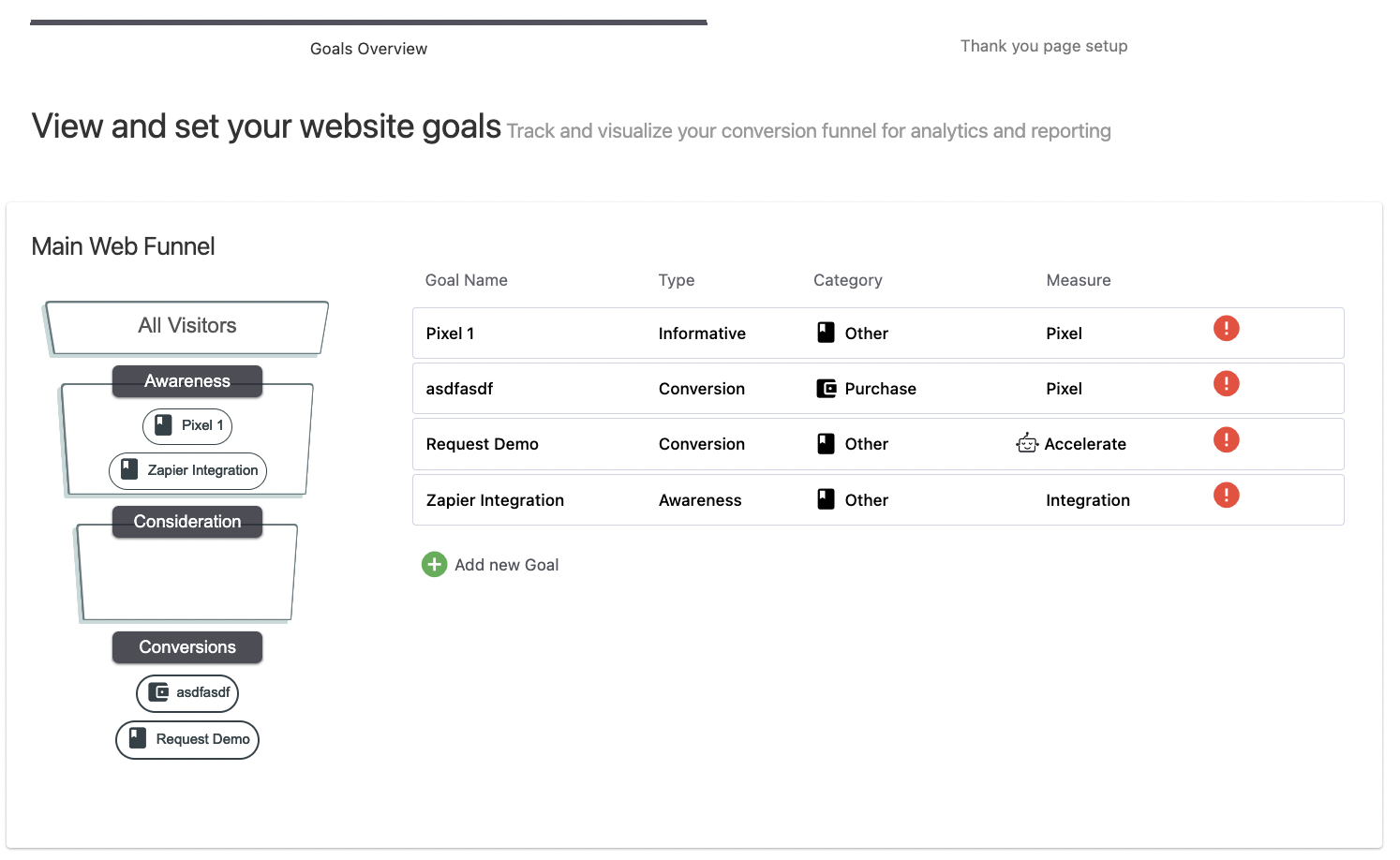
Select “Add new goal” and fill the information needed to track each one of your business goals.
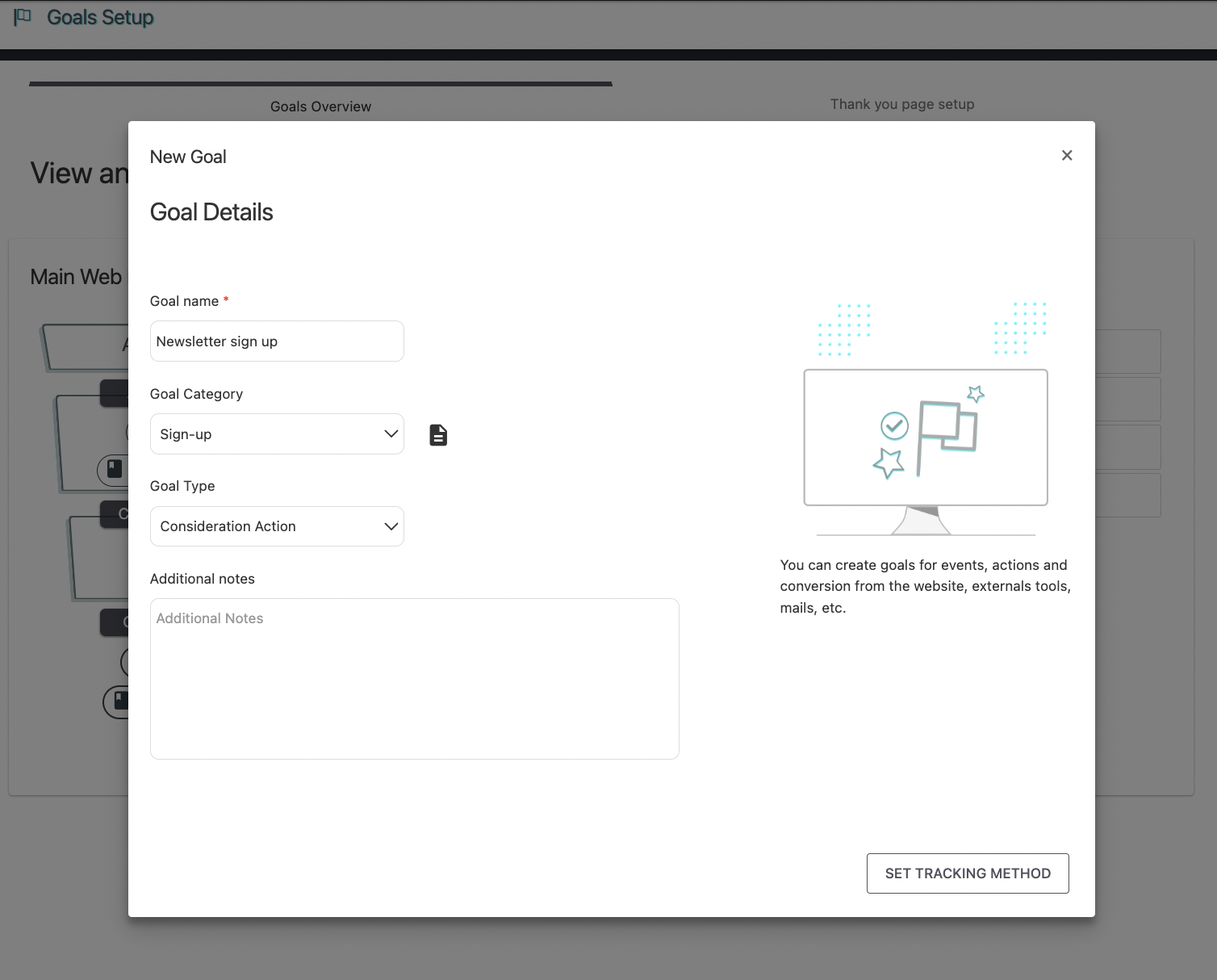
Next, select your preferred tracking method. You have several options, including:
- Tracking on URL load
- Tracking on pixel load
- Tracking when a user performs an action
- Using a third-party tracking tool
- Using a Pathmonk thank you page. We recommend this option because it eliminates the need to install any pixels, tags, or URLs; we will handle all the information transfer for you.
![]()
3. Analyze the Customer Journey
In your Pathmonk dashboard, navigate to the upper menu, click on “Intelligence,” and this time select “Analytics dashboard“.
Select the Buying Journey report, specify the time period you want to analyze, and apply a filter based on the goal to better understand the related touchpoints.
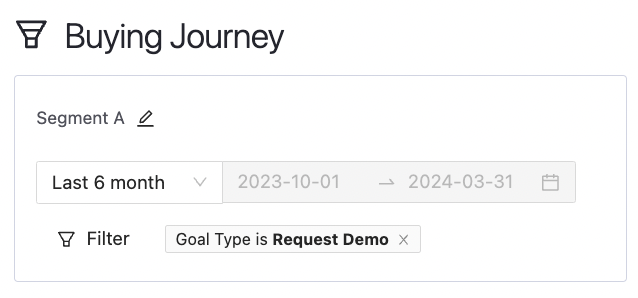
Now, scroll down to the Buying Journey Details section, click on Campaigns, and explore each stage of the funnel by campaign source, medium, or name. This analysis will help you identify which sources and actions are most effective at driving the desired outcomes.
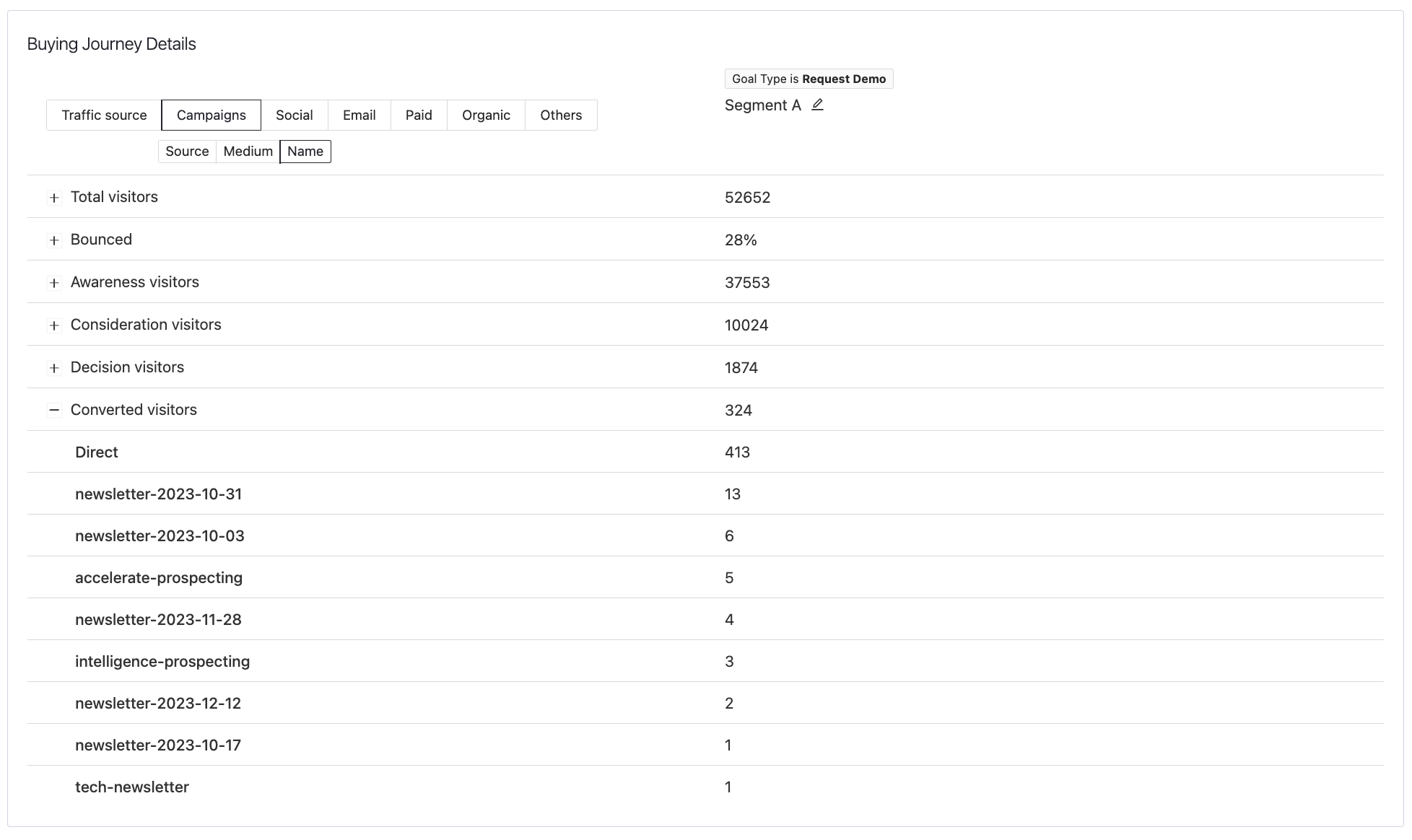
Why are Marketing Touchpoints Important for Customer Acquisition?
Understanding and optimizing your marketing touchpoints can be the difference between a flourishing customer base and a stagnant one. Marketing touchpoints, from your social media ads to your customer service calls, are crucial in not only attracting but also acquiring new customers.
Here’s why they are so indispensable:
1. Boosting Brand Awareness
Consistent exposure through multiple touchpoints increases brand awareness and keeps your brand top of mind.
Regular visibility, whether through email marketing, dynamic retargeting ads, or influential partnerships, helps ensure that when potential customers are ready to make a purchase, your brand is the first that comes to mind.
2. Generating and Nurturing Leads
Effective touchpoints are not just about visibility. They’re also about interaction. Whether through engaging content offers, newsletter sign-ups, or interactive tools, these touchpoints gather valuable consumer data. Once you have this data, you can nurture leads with personalized, relevant content that moves them down the sales funnel towards a purchase.
Generate better leads to grow your sales
Discover new strategies to unlocking a flood of high-quality leads from your website.
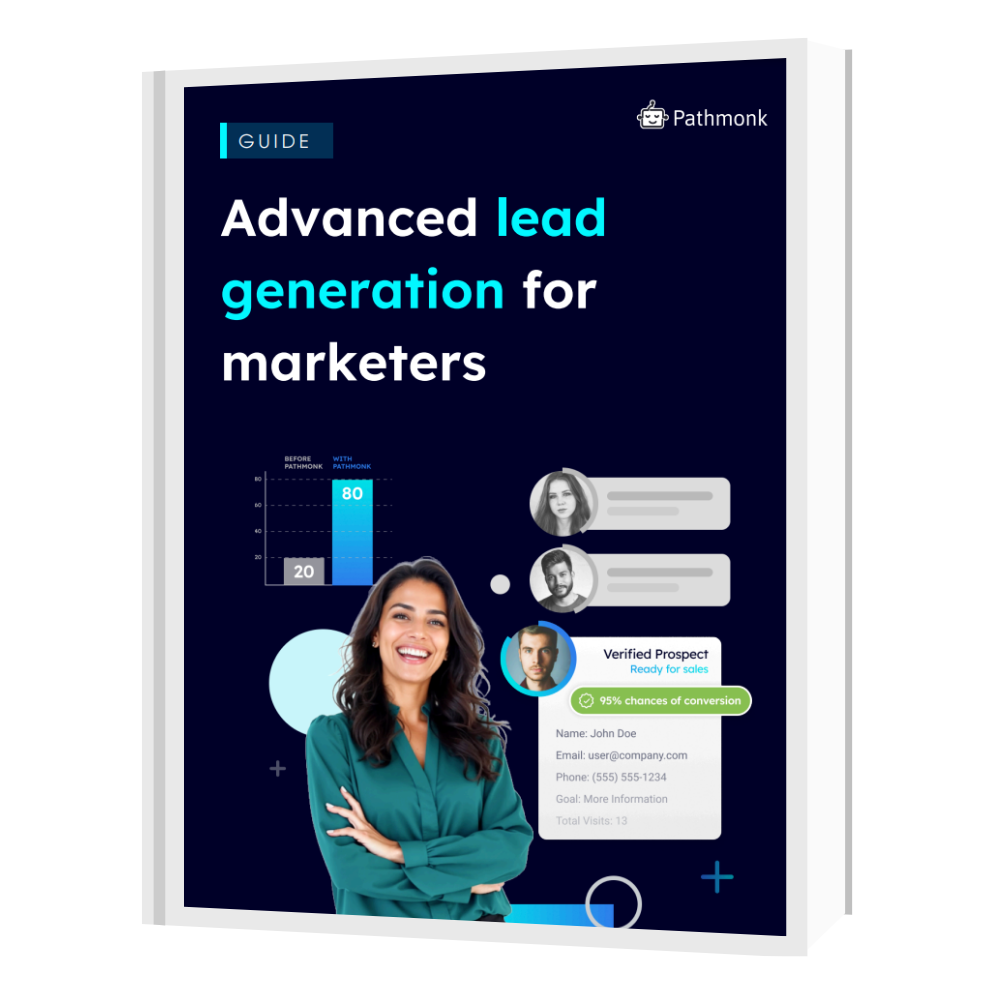
3. Educating Potential Customers
Information is power, and well-crafted touchpoints provide potential customers with the knowledge they need to make informed purchasing decisions. Detailed product descriptions, informative blog posts, and reviews help elucidate what sets your product or service apart, which is vital in guiding the purchase decision.
4. Building Trust
Trust is foundational in any relationship, as it is between a customer and a company. Regular, positive, and transparent communication through your touchpoints can establish and grow trust. Customer testimonials, case studies, and openly shared user feedback are touchpoints that show potential customers that they can rely on your brand.
5. Engaging with Your Audience
Interactive touchpoints, such as social media interactions, webinars, and live demos, provide opportunities to engage directly with potential customers. This engagement not only makes your brand more relatable but also increases the likelihood of prospects considering your brand when they’re ready to purchase.
Which Touchpoints are Most Critical in Driving Conversions and Why?
In the complex journey from a potential lead to a paying customer, certain touchpoints stand out as critical drivers of conversions. Understanding and optimizing these touchpoints can significantly boost your marketing effectiveness and sales outcomes. Here’s a look at some of the most impactful ones:
Website Landing Pages
Landing pages are often the first detailed interaction a potential customer has with your brand after clicking on an ad or link. Their importance lies in their focus on a single objective (e.g., newsletter sign-up, sale, registration) and their ability to be tailored for specific segments of your audience. Effective landing pages directly address the visitor’s needs and are optimized for conversion through clear, persuasive call-to-actions (CTAs).
Product Demonstrations or Trials
For many products, particularly software and complex goods, the opportunity to try before buying is a significant conversion driver. Demonstrations and free trials allow potential customers to experience the product firsthand, reducing their uncertainty and building trust in the product’s value.
Customer Reviews and Testimonials
In an era where consumers are increasingly skeptical of advertising and corporate messaging, peer reviews and testimonials serve as trusted sources of information. They often help to tip the balance in favor of conversion by offering real-world proof of product effectiveness and customer satisfaction.
Email Follow-ups
Emails are crucial in nurturing leads through the sales funnel. Personalized follow-up emails that respond to a user’s specific actions or inactions can re-engage potential customers, offer additional information, and guide them towards making a purchase.
Timing these emails to address the buyer’s journey stages is essential for maximizing their impact.
Retargeting Ads
Retargeting ads work by reminding users who have visited your site but didn’t make a purchase. Since these prospects have already shown interest in your products, retargeting keeps your brand top of mind and often addresses barriers to purchase with tailored messaging or offers.
Social Media Interaction
Interactions on social media platforms can significantly impact conversions by building a relationship with potential customers. Engaging content, timely responses to queries, and active community management help cultivate trust and loyalty. Additionally, social media platforms provide powerful tools for targeted advertising based on extensive demographic and behavioral data.
Pathmonk Intelligence: The Solution for Understanding Your Marketing Touchpoints
Mapping marketing touchpoints with traditional analytics tools like GA4 often presents significant challenges that can hinder a comprehensive understanding of the customer journey. These tools typically provide a fragmented view, excelling at tracking discrete actions such as page views and clicks but struggling to connect these actions into a coherent narrative that spans multiple sessions and devices.
Another common issue with traditional analytics platforms is their overreliance on last-click attribution models, where the last touchpoint before a conversion receives all the credit for the action, disregarding the role of earlier interactions. This approach can significantly distort the perceived effectiveness of earlier touchpoints in the journey. Additionally, the data collected by these tools is often compartmentalized by channel—information from social media, emails, and direct traffic is analyzed in isolation, without considering the interactions between these channels. This data fragmentation can obscure the holistic view of how different touchpoints collectively influence customer behavior.
But fear not, because this is how Pathmonk Intelligence addresses these challenges:
- Advanced journey mapping: Pathmonk Intelligence uses sophisticated algorithms to reconstruct the customer journey across multiple touchpoints, sessions, and devices. This gives marketers a holistic view of how customers interact with their brand over time, providing a deeper understanding of the journey that leads to conversions.
- Intelligent attribution models: Unlike traditional tools that may rely on simplistic attribution models, Pathmonk offers advanced attribution capabilities. It considers the impact of each touchpoint on the final conversion, allowing for a more balanced and accurate assessment of what really drives customer actions.
- Integration across channels: Pathmonk provides an integrated view of data from various channels, breaking down silos between different marketing platforms. This integration allows for a comprehensive analysis of how different channels and touchpoints contribute to the customer journey, enabling more effective cross-channel marketing strategies.
- No reliance on cookies: Acknowledging the limitations imposed by privacy regulations and cookie blocking, Pathmonk uses alternative cookieless methods to track user interactions. This results in more reliable data collection that isn’t affected by external changes in data privacy policies or technology.
How to Add Pathmonk Intelligence to Your Marketing Strategy
Step 1: Set Up your Pathmonk Intelligence Account
If you want a hands-on test of how Pathmonk Intelligence works and what it can do for you, sign up for a free Demo. This hands-on experience will provide you with valuable insights into how Pathmonk Intelligence can work to your advantage.
Alternatively, you can directly start your journey with Pathmonk Intelligence by signing up for an account.
Step 2: Onboarding and Installation
Once registered, the next step is to integrate Pathmonk Intelligence with your platform.
The onboarding process has been designed to be exceptionally user-friendly, making it a self-service experience that ensures you’re up and running smoothly.
Step 3: Data Configuration
Your business is one-of-a-kind, and so are your objectives. We encourage you to customize your data collection settings to precisely align with your unique business goals. This level of customization empowers you to tailor your goals, ensuring that you receive the most relevant insights that will truly impact your success.
You have the flexibility to establish your goals using various methods: through a URL, a pixel that doesn’t rely on cookies, or by integrating with a third-party application. No matter which option you choose, you won’t need developers. However, if you encounter any issues with your data configuration, you can always contact our support team.
Understand your customer journey analytics
See how your users behave, find drop-offs, and receive actionable insights with AI.

Applying Your Touchpoints’ Insights to your Marketing Strategy
Once you’ve mapped your marketing touchpoints and gathered insights from this data, the next step is to apply these findings effectively to refine and enhance your marketing strategy. This process is crucial for driving better engagement, increasing conversions, and achieving a higher return on investment. Here’s what you should do as a marketer with the outcomes derived:
- Prioritize High-Impact Touchpoints: Identify which touchpoints are most effective in driving customer engagement and conversions. Focus your efforts and resources on these areas to maximize their impact. For instance, if analytics show that email follow-ups lead to a high conversion rate, consider increasing the frequency of your emails or segmenting your audience more finely to tailor messages even more precisely.
- Optimize the Customer Journey: Use the insights gained from your touchpoint analysis to smooth out any friction points in the customer journey. If certain touchpoints are consistently associated with high drop-off rates, investigate why this might be happening. Is the messaging unclear? Is the navigation too complicated? Optimizing these touchpoints can lead to a more seamless experience that encourages customers to progress rather than abandon their journey.
- Integrate and Coordinate Across Channels: Ensure that your touchpoints are not only effective on their own but also work well together. Integrated marketing communication is key to creating a consistent brand message across all channels. This coherence helps reinforce your brand identity and can improve customer trust and loyalty.
- Personalize Customer Interactions: Leverage data from various touchpoints to personalize interactions with your customers. Personalization can range from simple measures, like addressing customers by name in emails, to more complex strategies, such as recommending products based on previous browsing behavior or purchases. Tailored interactions are often more engaging and can lead to higher conversion rates.
- Test and Iterate: The landscape of customer interaction is always changing, so continuous testing is crucial. Use A/B testing or multivariate testing to try out different approaches in your touchpoints. Analyze the results and continue to refine your approach. What worked once might not always yield the same results, and regular testing ensures that your strategies remain effective.
Translate all your data into clear insights
Discover how to future-proof your marketing data strategy with AI-powered analytics.
